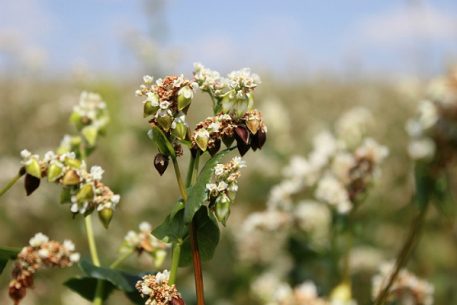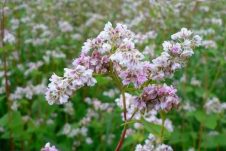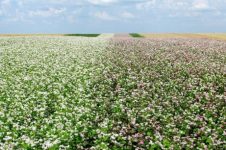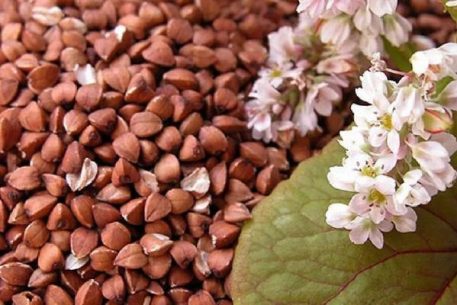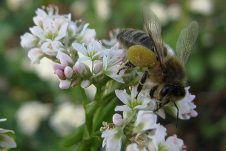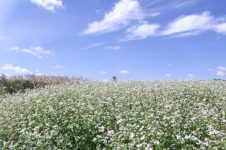Many people know how this cereal looks, but not everyone has seen how buckwheat grows. Blooming buckwheat fields are a wonderful sight. In people who choose a healthy lifestyle, buckwheat should be among the main foods.
Material Content:
Description and composition of buckwheat
There are buckwheat, thermally processed and raw or green. Unlike fried cereals, green buckwheat can sprout. Buckwheat can be stored for a long time. It is obtained after threshing and peeling the grains from the husk.

The composition of cereals includes:
- 60% carbohydrates (starch and sugar);
- well-digestible proteins (lots of lysine and methionine);
- fixed oils;
- organic acids;
- vitamins (riboflavin, thiamine, folic acid, tocopherol);
- mineral salts (Fe, P, Ca, I, Zn, Co).
Buckwheat is used in cooking for the preparation of various cereals, casseroles, buckwheat flour, salads with sprouted grains.
How does buckwheat grow, and what does it look like during flowering?
When buckwheat (Fagopyrum esculentum) begins to bloom, it looks very beautiful.
Flowers can be white and pink, they bloom in July.
Then small triangular seeds are tied, which ripen unevenly, some may crumble.
Buckwheat is a wonderful honey plant. In the summer, bees fly to blooming buckwheat fields to collect nectar and make a very fragrant, dark brown honey. For baking, such honey is a real find, with it golden cakes for honey and gingerbread are perfectly obtained.
There is a variety of buckwheat with green flowers called Zelenotsvetkovaya or Malikovskaya, bred in the 80s of the last century. It is characterized by high productivity, resistance to shedding grain from the stem.
Buckwheat growing areas in Russia
The most popular type of cereal - quick-digesting kernel is made in buckwheat growing areas. The seeds are steamed and separated from the shell, after which they darken. In this form, farmers send cereals to processors throughout the country.
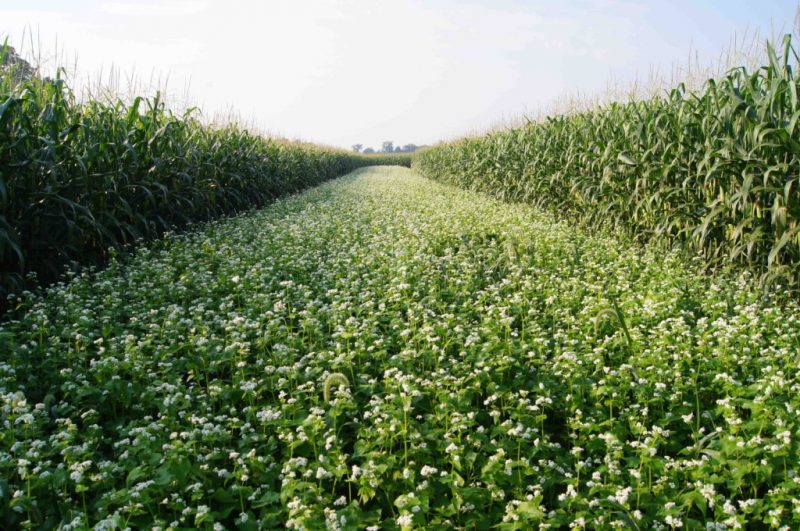
Large buckwheat fields are in Bashkiria, Tatarstan, Altai, Stavropol, Primorsky and Krasnodar Territories.
They grow groats in the vicinity of Orenburg, Orel, Lipetsk, Tula, Kursk, Volgograd, Saratov and Chelyabinsk.
In which countries does buckwheat grow
Russia is the world leader in buckwheat cultivation, the country produces half of the world crop, about 1.186 million tons. About 3 times less cereals are grown in China.
Other countries producers of buckwheat:
- France;
- Kazakhstan;
- Brazil;
- Japan;
- Latvia;
- Ukraine;
- Poland;
- USA;
- Lithuania;
- Tanzania;
- Belarus.
A small amount of the crop is harvested in other countries. In Europe, seed buckwheat is not popular, many residents of Great Britain and Germany have never tried it.
It is interesting:how pineapple grows in nature and at home
When the crop is harvested
Buckwheat is considered a late-ripening culture. Harvest in the bins begin in late August or early Septemberwhen there is no rain. Under favorable weather conditions (humidity and air temperature), buckwheat grows in height about 1 meter. The cereal matures often unevenly, at the top it is already dry, and at the bottom it is still green.

After the ripening of the crop, it is mowed and threshed. Finished grain is sorted, and sent to a warehouse for storage for the winter. A part is left as seed, the rest is realized.
Interesting facts about buckwheat
Buckwheat has spread around the world from India and Nepal. The history of its cultivation in South Asia is solid - about five thousand years. In the wild, the plant can still be found on the mountain slopes of the Himalayas.
This cereal was especially fond of the Slavs for its high nutritional value and useful properties. In the national calendar, June 26 is the day of Shark-buckwheat. This saint was considered the patroness of the buckwheat crop, and her day was the last when it was possible to sow culture.
Due to the low yield, buckwheat is not popular in Europe. Only Russia can afford the luxury of growing it in large quantities.
And this grits is really unique:
- By the composition of amino acids that are indispensable for humans, it approaches the products of animal origin.
- The protein contained in cereal is assimilated by almost 80%.
- Croup has a low glycemic index. After buckwheat porridge, blood sugar decreases, as does the amount of bad cholesterol, so it is useful for diabetics.
- Buckwheat carbohydrates are slowly processed by the body, retaining a feeling of satiety for a long time.
It is interesting that in China, tea is made from green, not fried grains of buckwheat. This plant has healing parts, not just grain. To prepare tinctures and broths, flowering tops and young green leaves are collected.
Buckwheat is used in the treatment of:
- high blood pressure;
- atherosclerosis;
- diathesis;
- measles
- radiation sickness;
- scarlet fever;
- varicose veins;
- rheumatism;
- hemorrhoids;
- arthritis.
Croup is useful for the prevention of sclerosis in diseases of the liver, nervous and cardiovascular systems.
For lovers to eat sweets, caught in an insidious trap of excess weight, information will be interesting that simple buckwheat porridge is able to cheer up. This dish increases the level of the neurohormone dopamine, which is responsible for the desire to actively move and achieve goals.
Traditionally, traditional healers have used buckwheat decoction to treat colds and dry coughs. Brewed flowers and leaves, collected and dried in July.Groats are especially useful for pregnant and lactating women. It contains a lot of iron to prevent fetal anemia and hypoxia. Folic acid, which is part of cereals, also stimulates blood formation, increases immunity and protective functions of the body, and removes toxins.
Buckwheat flour is used in cosmetology. Add it to the composition of therapeutic masks to relieve skin inflammation, redness, itching, an allergic reaction. Fresh buckwheat leaves are applied to the wounds for quick healing.
Here is such a unique plant ordinary buckwheat. You can eat it without waiting for adversity and disease, with milk, meat or vegetables every day.


